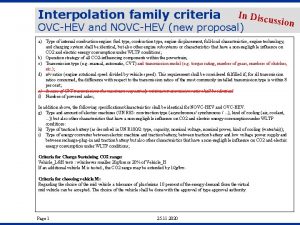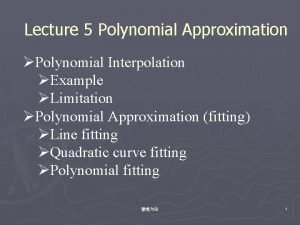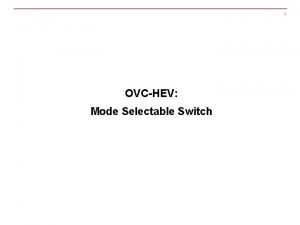Interpolation family criteria In Discu ssion OVCHEV and


- Slides: 2

Interpolation family criteria In Discu ssion OVC-HEV and NOVC-HEV (new proposal) a) Type of internal combustion engine: fuel type, combustion type, engine displacement, full-load characteristics, engine technology, and charging system shall be identical, but also other engine subsystems or characteristics that have a non-negligible influence on CO 2 and electric energy consumption under WLTP conditions; b) Operation strategy of all CO 2 -influencing components within the powertrain; c) Transmission type (e. g. manual, automatic, CVT) and transmission model (e. g. torque rating, number of gears, numbers of clutches, etc. ); d) n/v ratios (engine rotational speed divided by vehicle speed). This requirement shall be considered fulfilled if, for all transmission ratios concerned, the difference with respect to the transmission ratios of the most commonly installed transmission type is within 8 per cent; e) In case of CVT transmissions the maximum respectively minimum transmission ratio shall be identical f) Number of powered axles; In addition above, the following specifications/characteristics shall be identical for NOVC-HEV and OVC-HEV. g) Type and amount of electric machines (UN R 85: construction type (asynchronous/ synchronous /. . . ), kind of cooling (air, coolant, . . . )) but also other characteristics that have a non-negligible influence on CO 2 and electric energy consumption under WLTP conditions: h) Type of traction battery (as described in UN R 100/2: type, capacity, nominal voltage, nominal power, kind of cooling (water/air)); i) Type of energy converter between electric machine and traction battery, between traction battery and low voltage power supply and between recharge-plug-in and traction battery but also other characteristics that have a non-negligible influence on CO 2 and electric energy consumption under WLTP conditions; Criteria for Charge Sustaining CO 2 range: Vehicle_L&H tests : whichever smaller 20 g/km or 20% of Vehicle_H If an additional vehicle M is tested , the CO 2 range may be extended by 10 g/km. Criteria for choosing vehicle M: Regarding the choice of the mid vehicle a tolerance of plus/minus 10 percent of the energy demand from the virtual mid vehicle can be accepted. The choice of the vehicle shall be done with the approval of type approval authority. Page 1 25. 11. 2020

Interpolation family criteria PEV(new proposal) In Discu Unless vehicles are identical with respect to the following electric powertrain/electric machine/transmission characteristics, they shall not be considered to be part of the same vehicle family for PEVs: a. Type and amount of electric machines (UN R 85) but also other characteristics that have a non-negligible influence on electric energy consumption and range under WLTP conditions: construction type (asynchronous/ synchronous /. . . ), kind of cooling (air, coolant, . . . ); full-load characteristics b. Type of traction battery (as described in UN R 100/2 type, capacity, nominal voltage, nominal power, kind of cooling (water/air)); c. Transmission type (e. g. manual, automatic, CVT) and transmission model (e. g. torque rating, number of gears, numbers of clutches, etc. ); d. Number of powered axles; e. Type of electric converter between electric machine and traction battery, between traction battery and low voltage power supply and between recharge-plug-in and traction battery but also other characteristics that have a non-negligible influence on electric energy consumption and range under WLTP conditions: full-load characteristics, electric inverter technology f. Operation strategy of all components influencing the electric energy consumption within the powertrain; g. n/v ratios (engine rotational speed divided by vehicle speed). This requirement shall be considered fulfilled if, for all transmission ratios concerned, the difference with respect to the transmission ratios of the most commonly installed transmission type is within 8 per cent; Page 2 25. 11. 2020 ssion



